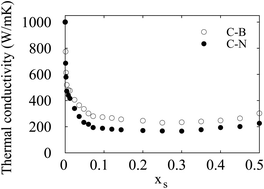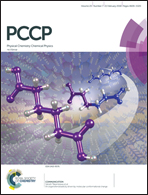Reduction of the thermal conductivity of a graphene/hBN heterobilayer via interlayer sp3 bonds
Abstract
Thermal conductivities (TCs) of graphene (g)/hexagonal boron nitride (hBN) heterobilayers with interlayer sp3 bonds are computed using nonequilibrium molecular dynamics (NEMD) simulations. It is revealed that the TC of a g/hBN heterobilayer drastically decreases if there is even a few interlayer sp3 bonds, and continues to gradually decrease upon increasing their fraction up to 0.25, where the fraction of the interlayer sp3 bonds is defined by the atomic fraction of interlayer-sp3-bonded carbon atoms within graphene constituting a g/hBN heterobilayer. If their fraction exceeds 0.25, the TC of a g/hBN heterobilayer gradually increases, namely, the TC of a g/hBN heterobilayer takes a minimum at the fraction of 0.25 of the interlayer sp3 bonds. In order to understand such a behavior of the TC of the heterobilayer, the local phonon density of states (DOSs) in each of the two layers is calculated. By examining the local phonon DOSs, it was found that the existence of the minimum TC of the heterobilayer can be understood by considering both the phonon scattering and the characteristic change of the heterobilayer structure. In the range of the low fractions of interlayer sp3 bonds, the van der Waals (vdW) interactions are predominantly effective for binding the two layers, and the interlayer sp3 bonds act as phonon scatterers like defects to make the TC of the heterobilayer decrease. Upon increasing the fraction of interlayer sp3 bonds, the contribution of the interlayer sp3 bonds to the unification of the two layers becomes stronger, and hence the rigidity of the heterobilayer structure gradually increases. If their fraction exceeds 0.25, the heterobilayer structure approaches a quasi-three-dimensional one, so that the TC of the heterobilayer increases. These findings will be useful for tuning the TCs of g/hBN heterobilayers via interlayer sp3 bonds.



 Please wait while we load your content...
Please wait while we load your content...